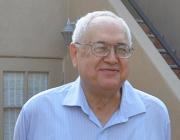Date Published:
APR 27Abstract:
Photochemical processes in HNO3, HNO3-H2O, and cis- and trans-HONO following overtone excitation of the OH stretching mode are studied by classical trajectory simulations. Initial conditions for the trajectories are sampled according to the initially prepared vibrational wave function. Semiempirical potential energy surfaces are used in ``on-the-fly'' simulations. Several tests indicate at least semiquantitative validity of the potential surfaces employed. A number of interesting new processes and intermediate species are found. The main results include the following: (1) In excitation of HNO3 to the fifth and sixth OH-stretch overtone, hopping of the H atom between the oxygen atoms is found to take place in nearly all trajectories, and can persist for many picoseconds. H-atom hopping events have a higher yield and a faster time scale than the photodissociation of HNO3 into OH and NO2. (2) A fraction of the trajectories for HNO3 show isomerization into HOONO, which in a few cases dissociates into HOO and NO. (3) For high overtone excitation of HONO. isomerization into the weakly bound species HOON is seen in all trajectories, in part of the events as an intermediate step on the way to dissociation into OH + NO. This process has not been reported previously. Well-established processes for HONO, including cis-trans isomerization and H hopping are also observed. (4) Only low overtone levels of HNO3-H2O have sufficiently long liftimes to be spectrocopically relevant. Excitation of these CH stretching overtones is found to result in the dissociation of the cluster H hopping, or dissociation of HNO3 does not take place. The results demonstrate the richness of processes induced by overtone excitation of HNOx species, with evidence for new phenomena. Possible relevance of the results to atmospheric processes is discussed.
